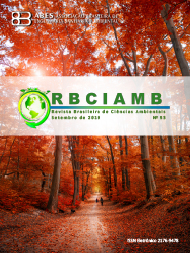HYDROSSEDIMENTOLOGICAL CONTRIBUTION OF RURAL ROADS IN RIVER BASINS WITH SMALL AND MEDIUM PROPERTIES
DOI:
https://doi.org/10.5327/Z2176-947820190503Keywords:
hydrological model, rural roads, SWAT, scenario analysisAbstract
Hydrosedimentological studies address the contributions of agriculture, urban
environment, and other land occupations. However, rural roads within the
watersheds are hardly seen as a specific or potential contribution. Thus, the
aim of this study is to simulate different scenarios and characteristics for rural
roads and assess its the flow of water and sediments in family farming basins
located in the southern brazil. For this, the soil and water assessment tools
(swat) hydrological simulation model was applied. In the flow calibration
stage for the Concórdia stream basin, a nash-sutcliffe coefficient (COE) of
0.76 was obtained, and for validation, a coefficient of 0.78. While in the
Camboriú river basin, the COE reached 0.67. For sedimentological calibration
and validation, the Concórdia creek basin obtained an COE of 0.82 and 0.68,
respectively. While in the Camboriú river basin, sedimentological calibration
reached a coefficient of 0.59. When compared to the scenario without the
roads, the insertion of rural roads as specific land use resulted in a 6.3%
increase in flow rate and 8.8% in sediments transported in the Concórdia
creek basin. For the Camboriú river basin, the differences were below 0.4%.
Therefore, even with a small area within the basin, rural roads may interfere
with the flow and volume of transported sediment.
Downloads
Downloads
Published
How to Cite
Issue
Section
License
Copyright (c) 2019 Revista Brasileira de Ciências Ambientais

This work is licensed under a Creative Commons Attribution 4.0 International License.



























